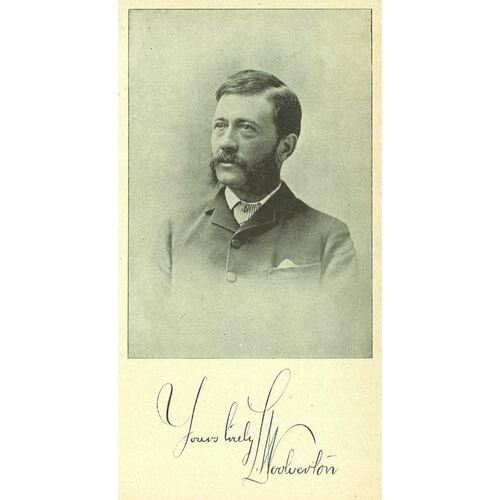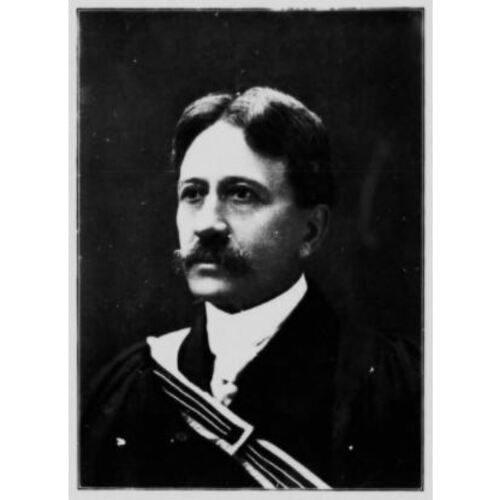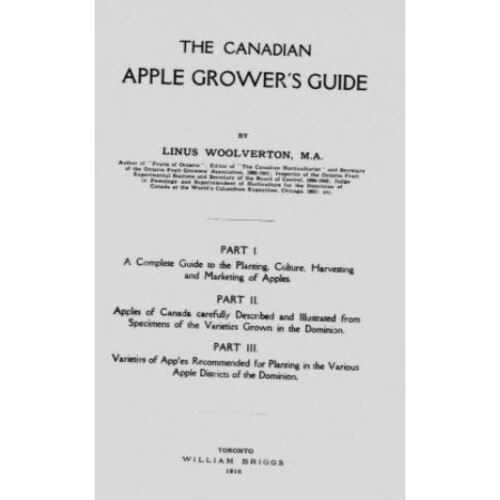![Linus Woolverton. From The Canadian horticulturist [Vol. 16, no. 1 (Jan. 1893)], Toronto: Fruit Growers' Association of Ontario. Original title: Linus Woolverton. From The Canadian horticulturist [Vol. 16, no. 1 (Jan. 1893)], Toronto: Fruit Growers' Association of Ontario.](/bioimages/w600.11991.jpg)
Source: Link
WOOLVERTON, LINUS, fruit grower, horticulturist, editor, author, and office holder; b. 12 Dec. 1846 in Grimsby Township, Upper Canada, son of Charles Edward Woolverton and Delight Bennet; m. first 18 Oct. 1870 Sarah Frances Lorimer in Toronto, and they had two sons and one daughter; m. secondly 2 May 1903 Lizzie Frances Oakley in Grimsby, Ont.; d. near there 7 May 1914.
Linus Woolverton spent most of his life on land purchased in 1802 by his great-grandfather Jonathan Woolverton upon his arrival in Grimsby Township from New Jersey. Two hundred acres – reaching from the Niagara Escarpment to Lake Ontario – came down to Linus through his grandfather Dennis Woolverton and his father. Although Jonathan and Dennis grew apples and some peaches, this farm – like others in the Niagara peninsula – was one of mixed crops. Its conversion to the Maplehurst Fruit Farm, which Linus would make widely known, began in 1856 when his father and Andrew Murray Smith* formed a partnership to produce nursery stock and fruit there. In 1859 they were among the constituent members of the Fruit Growers’ Association of Upper Canada.
After attending Grimsby High School and studying for a year at the University of Rochester, in New York State, Linus Woolverton entered the University of Toronto with a scholarship, studied natural sciences and humanities, and received a ba in 1869. He read law briefly in 1869–70 and went on to receive an ma from Toronto in 1870.
On his return to Grimsby, Woolverton became involved in his father’s nursery business. A Baptist like his father, he also became an examiner in classics and English at the Canadian Literary Institute, a church-affiliated school in Woodstock, Ont. In 1875, following the dissolution of Woolverton and Smith, he took over management of his father’s farm. Although it had many established fruit trees, the thousands more he planted took time to come into bearing. As he would reflect after 16 years, “I must confess to having been myself somewhat duped by reading glowing descriptions of the enormous profits of fruit-culture.” He was a good horticulturist and businessman, however, and Maplehurst prospered. By the turn of the century, markets in England, Scotland, France, and Australia were receiving its fancy apples.
In 1886 Woolverton gave up the Woodstock position and succeeded Delos White Beadle* as secretary-treasurer of the Fruit Growers’ Association of Ontario and as editor of its monthly, the Canadian Horticulturist. Under his guidance and with his own frequent contributions, it soon came to reflect his experience as a fruit grower, his literary and scientific education, and his awareness of current horticultural literature.
The periodical also revealed his interest in ornamental horticulture and the City Beautiful movement. As early as 1889 he set forth principles of home-landscape beautification apparently gleaned from American books and magazines. In 1900 he published four articles by Warren Henry Manning, a prominent Boston landscape architect whom he had met the previous year. In March 1903, after attending the founding of the Canadian League for Civic Improvement in Toronto in February and becoming a director, he began a department within the Canadian Horticulturist to promote “the improvement of the surroundings of our Canadian town and country homes.” The results may have been disappointing: in 1911 he wrote regretfully of the lack of Canadian recognition of the landscape gardening profession. (Although he did not name the two experts – “one in Ontario and another in Quebec” – whom he mentioned, they were almost certainly his son Charles Ernest of Grimsby and Frederick G. Todd* of Montreal.)
Woolverton contributed to other publications. A humorous letter to the Canada Farmer (Toronto) in 1872, “Ants to blame for the aphides!,” may have been his first appearance in print. Between 1885 and 1910 he wrote more than 40 articles for Ontario periodicals, mainly the Farmer’s Advocate and Home Magazine. Elected about 1890 as vice-president for Ontario of the American Pomological Society, he also wrote for its reports. He was a corresponding member of the Hamilton Association for the Advancement of Literature, Science, and Art and contributed a paper, apparently on fruit fungi, to its journal of 1891–93.
While editor of the Canadian Horticulturist, he travelled frequently: across Ontario for annual fruit growers’ meetings; to Ottawa in 1890 for a convention of fruit growers and federal officials, which established the Dominion Horticultural Association and appointed him to its executive committee; to Chicago in 1893 for the Columbian exposition, where he was a judge in pomology and superintendent of Canada’s horticultural exhibits; and to Toronto in 1894 to receive an ma from McMaster University.
Beginning in 1894, as secretary of the Fruit Growers’ Association of Ontario, he was also secretary and an ex officio member of the board of control of the Fruit Experiment Stations of Ontario. His duties included inspections, often with Professor Howard Laing Hutt of the Ontario Agricultural College, of more than a dozen stations – Maplehurst itself was one from 1896 – and responsibility for the fruit display at the annual industrial fair in Toronto. Woolverton’s most consuming duty, however, was the preparation of a publication to “contain all the information necessary” for the fruit growers of Ontario to select which cultivars to plant. His evaluations, with photographs, began appearing in 1898 in the board’s annual reports. The work took longer than anyone anticipated. To gain time for it he resigned as secretary-treasurer of the fruit growers’ association in 1902 and as editor of the Canadian Horticulturist two years later. The fruits of Ontario, 1906, which incorporated assessments of more than 400 cultivars, was finally published in 1907. Although it named no author, the introduction credited Woolverton for his ten years of work and his “excellent illustrations and full descriptions.” A revised edition would appear in 1914, unfortunately with no mention at all of his name. Both editions are valuable to present-day horticultural historians for their detailed records of fruits grown in Ontario prior to World War I.
Woolverton’s role as secretary of the board of control continued until its dissolution in 1908; his position as an official experimenter ended with the closing of the Maplehurst station in 1909. He then worked on his own book, The Canadian apple grower’s guide (Toronto, 1910), which became the authoritative Canadian pomological reference work of its time.
During his last years Woolverton became active in St Andrew’s Anglican Church and he prepared a manuscript on its history that would be published in 1919. Despite a slight stroke in 1912, he continued to make his regular trip into Grimsby – he owned commercial property there – until the day of his death in 1914, on the farm where he had been born. The Beamsville Express eulogized him as “one of the best posted and most prominent fruit growers in Canada.”
Linus Woolverton’s assessments of Ontario fruits were published in Fruit Experiment Stations of Ontario, Annual report (Toronto), 1898–1904, under the title “Fruits of Ontario, described and illustrated by L. Woolverton”; the first of them was also published in monograph form (Toronto, 1898). The cumulated edition was issued by Ontario’s Dept. of Agriculture as The fruits of Ontario, 1906 (Toronto, 1907), and the revised edition by the department’s fruit branch as The fruits of Ontario (1914). The complete collection of fruit reports was also published in the Dept. of Agriculture, Annual report, 1898–1904, 1906, and 1913, and in Ont., Legislature, Sessional papers, 1899–1905; 1906, no.24; and 1914, no.33.
A listing of Woolverton’s numerous credited and uncredited articles, notes, and editorials in the Canadian Horticulturist (St Catharines, Ont.; Toronto; etc.), 1 (1878)–34 (1911), is available in Science and technology biblio. (Richardson and MacDonald). His contributions to other agricultural journals between 1872 and 1910 are listed in Ontario rural society, 1867–1930: a thematic index of selected Ontario agricultural periodicals, comp. Edwinna von Baeyer (pamphlet enclosing microfiche, Ottawa, 1985; copy at AO).
Woolverton’s publications include a description of “The experimental grounds of the Canadian Horticulturist” in the Canadian Horticulturist (Toronto), 13 (1890): 35 and facing photograph; “The establishment of schools in Grimsby” in the establishment of schools and colleges in Ontario, 1792–1910, ed. J. G. Hodgins (3v., Toronto, 1910), 1: 255; eight biographical sketches of North American horticulturists in the Standard cyclopedia of horticulture . . . , ed. L. H. Bailey (6v., New York, 1914–17), 3: 1563–603; and History of St. Andrew’s Church, Grimsby, Ont. ([Grimsby?, 1919]; copy in AO, Pamphlet Coll., 1919, no.61).
AO, F 1257-4; F 1257-5; RG 22–235, nos.2206, 3108, 3714; RG 80–5-0–20, vol. 19: f.281; RG 80-5-0-314, no.12050. NA, RG 31, C1, 1871, Grimsby Township, Ont., div.1: 13 (mfm. at AO). Beamsville Express (Beamsville [Lincoln], Ont.), 13 May 1914. “L. Woolverton,” Beamsville Express, “Beamsville, Grimsby and Grimsby Park illustrated, souvenir number,” July 1898 (unpaginated; copy in Brock Univ. Library, Special Coll., St Catharines). [Significant portions of this article plagiarize a 1893 sketch in the Canadian Horticulturist (cited below), and because phrases such as “last year” and “three years ago” remain unchanged, it can be quite misleading. p.c.] Canadian men and women of the time (Morgan; 1912). Fruit Growers’ Assoc. of Ontario, Annual report (Toronto), 1886–1908. “Loyalist and pioneer families of West Lincoln, 1783–1833,” comp. R. J. Powell, Annals of the Forty (Grimsby), no.9 (1958): 71–76. Proceedings of a convention of fruit growers of the Dominion of Canada held at Ottawa on the 19th, 20th, and 21st February, 1890 (Ottawa, 1890), 148. “Prominent Canadian horticulturists – xiv: Mr. Linus Woolverton, ‘The Secretary,’” Canadian Horticulturist, 16 (1893): 10–13.
Cite This Article
Pleasance Crawford, “WOOLVERTON, LINUS,” in Dictionary of Canadian Biography, vol. 14, University of Toronto/Université Laval, 2003–, accessed December 31, 2025, https://www.biographi.ca/en/bio/woolverton_linus_14E.html.
The citation above shows the format for footnotes and endnotes according to the Chicago manual of style (16th edition). Information to be used in other citation formats:
| Permalink: | https://www.biographi.ca/en/bio/woolverton_linus_14E.html |
| Author of Article: | Pleasance Crawford |
| Title of Article: | WOOLVERTON, LINUS |
| Publication Name: | Dictionary of Canadian Biography, vol. 14 |
| Publisher: | University of Toronto/Université Laval |
| Year of publication: | 1998 |
| Year of revision: | 1998 |
| Access Date: | December 31, 2025 |





